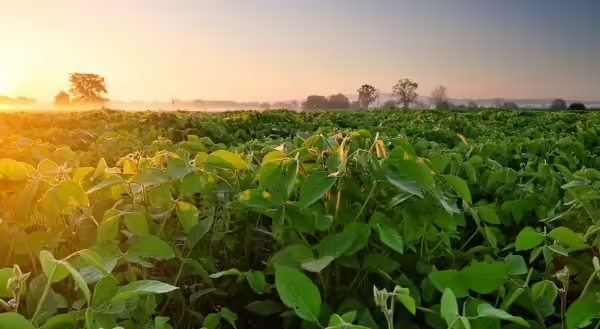
As the growing season fast approaches, farmers need to prepare for the fertility needs of their crops. While soybeans may not require nitrogen like corn does, this crop has its unique nutrient requirements. In addition to phosphate and potash, soybeans also need sufficient sulfur to produce a strong, healthy crop.
Sulfur is one of the 17 essential plant nutrients that all crops require. In soybeans, sulfur is important for optimal growth during both the vegetative and reproductive stages of the plant. It is also required for nitrogen fixation. Soybeans are capable of fixing their own nitrogen from the atmosphere by forming beneficial relationships with bacteria in their root nodules. Sulfur is required for nodule formation and function. Sulfur is also an essential building block of amino acids, which are found in the protein of soybean seeds and is what determines the quality of it as an animal feed.
Most sulfur in the soil is found in organic matter. As the organic matter breaks down, a process called mineralization, releases plant-available sulfur to crops. Sulfur is also highly mobile in the soil, and heavy rainfall can cause leaching. Because of this, growers with sandy or coarse-textured soils should monitor for sulfur deficiencies. In soybeans, a sulfur deficiency manifests as pale green or yellow leaves without prominent veins or necrosis in the youngest trifoliate leaves.
Sulfur can also be found in the atmosphere as sulfur dioxide. This form of sulfur is released into the atmosphere by coal-burning power plants. It ultimately makes its way into the soil and is mineralized to plant-available sulfate. As we move away from fossil fuels, less sulfur is being deposited into the soil from the atmosphere. This is why farmers now may need to apply additional sulfur when this wasn’t necessary in the past.
One important thing to note is that the symptoms of early-season sulfur deficiencies may disappear as sulfur becomes more available to plants during the summer as root systems continue to develop. Sulfur concentrations vary throughout the soil profile, so as the growing season progresses more sulfur may become available for plants.
Growers are encouraged to strip-test their soils if they believe sulfur is limiting the yield potential of their crops. New research from Iowa and Indiana shows yield increases in soybeans with the addition of sulfur. Soybeans require 0.35 lb/bu sulfur from all sources to produce a successful crop. Sulfur can be added to soils by applying ammonium sulfate (24% S), gypsum (16-18% S), elemental sulfur (99% S), and many others. Sulfur is also available as a foliar treatment for later in the growing season. Each of these sources varies in their availability to plants, with elemental sulfur taking up to a year to become available, so growers should be mindful of this when choosing a sulfur source.
More information about managing soybeans can be found in University of Illinois Extension’s Illinois Soybean Management 2023 guide.
Emily Hansen is a Commercial Agriculture Educator with University of Illinois Extension, serving Bureau, LaSalle, Marshall, and Putnam counties. Emily provides research-based educational programs that empower growers to make sustainable choices on their farms.
Casteel, S. (2019). Soybean’s Element Of Surprise: Sulfur. https://www.youtube.com/watch?v=a6pIukTHM-k
Hitsuda, K., Toriyama, K., Subbarao, G. V., & Ito, O. (2008). Sulfur Management for Soybean Production. In Sulfur: A Missing Link between Soils, Crops, and Nutrition (pp. 117–142). John Wiley & Sons, Ltd. https://doi.org/10.2134/agronmonogr50.c8
Mikkelsen, R., & Norton, R. (2013). Soil and fertilizer sulfur. Better Crops, 97(2), 9.
Nafziger, E. (2019, March 12). Early-Season Soybean Management for 2019. Farmdoc. https://farmdoc.illinois.edu/field-crop-production/crop_production/early-season-soybean-management-for-2019.html
Preza Fontes, G., Hager, A., Mideros, S., & Seiter, N. (2023). Illinois Soybean Management 2023.